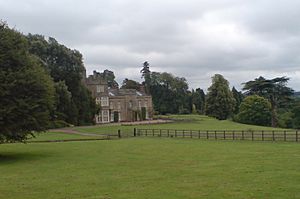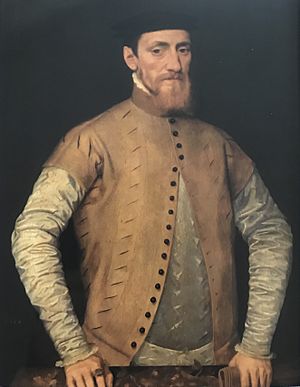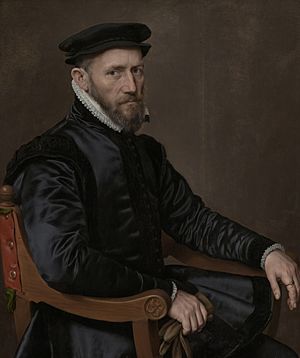Titsey Place facts for kids
Quick facts for kids Titsey Place and Gardens |
|
|---|---|

Titsey Place, front view of main house
|
|
| Type | Charitable trust |
| Location | Near Oxted in Surrey, England |
| Area | 3,000 acres (1,200 ha) |
| Created | 1979 |
| Operated by | The Titsey Foundation |
| Website | www.titsey.org |
Titsey Place is a beautiful old country house located near Oxted in Surrey, England. For many years, it was the home of two important families, the Gresham family and later the Leveson-Gower family.
Today, Titsey Place is looked after by a special group called a charitable trust. This trust makes sure the house and its lovely gardens are kept safe for everyone to enjoy.
The house you see today started as a building from the 1500s. Sir John Gresham built it on the spot where an even older house once stood. Over the years, the house was changed a lot. It was rebuilt in the 1700s and got a new front in 1826. A tall tower was added in 1856, giving it the look it has now.
Contents
A Look Back in Time
Early Days of Titsey
Long ago, in the Middle Ages, Titsey was owned by the Uvedale family. This family was quite important in the area. Several members of the Uvedale family served as High Sheriff of Surrey and High Sheriff of Hampshire. This was a very important job, like being a chief officer for the king in the county.
The Gresham Family Arrives
In the 1500s, the Gresham family became very powerful and rich. Sir John Gresham, a wealthy merchant from London, bought Titsey Place. He bought it from the people who inherited it from John Bourchier, 2nd Baron Berners. King Henry VIII had given the property to Baron Berners.
Sir John Gresham built a new house near the local church. He was also the Lord Mayor of London in 1547, which was a very important position.
Generations of Greshams
After Sir John Gresham, the house and land passed down through his family. His grandson, Sir Thomas Gresham, and then his great-grandson, Sir Edward Gresham, lived there.
The Gresham family became even more important when King Charles II made them Baronets in 1660. This was when he returned to the throne after a period of civil war. The house stayed with the Gresham Baronets for many generations.
The last Gresham to own Titsey was Sir John Gresham, the 6th Baronet. When he passed away in 1801, his daughter inherited the house. She married into the Leveson-Gower family. This family was related to the Dukes of Sutherland, a very important noble family.
How the House Changed Over Time
The original house from the Tudor period was taken down and rebuilt in the 1700s by the last Gresham baronet. Then, in 1826, the house got new fronts designed by an architect named William Atkinson. Later, in 1856, a tower was added by Philip Charles Hardwick.
What People Said About Titsey
In 1821, a book called Views of the Seats of Noblemen and Gentlemen, in England, Wales, Scotland, and Ireland described Titsey Place. It said the house "stands in a beautiful dell formed by a range of lofty chalk hills sheltering it from the north." This means it was in a lovely valley, protected by tall hills.
Another book from 1844, A Topographical History of Surrey, also talked about the house. It mentioned that Titsey Place was a "modern structure" and was "pleasantly situated." It also said the house had been greatly improved and looked very handsome. The book noted that the library had a "very fine portrait of Sir Thomas Gresham," painted by Sir Antonio More. Sir Thomas Gresham was famous for founding the Royal Exchange in London.
The Old Church and Graveyard
Many members of the Uvedale family, who owned Titsey long ago, are buried in what is now the garden of Titsey Place. This area used to be the local churchyard.
The last Gresham owner of Titsey took down the old church in 1776. He then made the church's land part of his large park. By 1865, a large yew-tree was the only thing that showed where the old church used to be.
Famous Cricketers from Titsey
Two members of the Leveson-Gower family who lived at Titsey Place were famous cricketers. Sir Henry Gresham Leveson Gower (1873–1954) was born at Titsey Place. He was even the captain of the England cricket team in 1909-1910. His relative, Frederick Leveson-Gower (1871–1946), also played first-class cricket.
Titsey Today
The Leveson-Gower family lived at Titsey Place until Thomas Leveson Gower passed away in 1992. In his will, he set up a special charitable trust. This trust was created to make sure the house and gardens would be kept safe for everyone to visit and enjoy. The rest of his estate was left to his heir, David Innes. David Innes also became a governor of the charitable trust.
Exploring Titsey Place
Inside the House
Titsey Place is well-known for its amazing collection of family portraits. Many of these paintings hang in the main entrance hall. You can see works by famous artists like Sir Joshua Reynolds and Peter Lely.
The new dining room has four beautiful paintings of Venice by the artist Canaletto. The sitting-room has old wooden panels and a unique design. The gallery bedroom shows off an impressive Georgian style.
Discovering the Gardens
After World War II, the gardens were in a very poor state. But Thomas Smith and his team worked hard to bring most of them back to life. Smith also created a wonderful collection of orchids. He grew fruits and vegetables in the kitchen-garden for the estate and for shops in nearby Oxted.
Since 1992, the house and the rest of the gardens have been carefully restored. The kitchen-garden was even changed to look more like a Victorian garden. Both the house and gardens are open to the public during the summer months.
The wider estate covers about 3,000 acres (1,200 ha) of land. There are miles of woodland paths along the edge of the North Downs. More than 20,000 visitors enjoy these walks every year.
Titsey Place gets support from the Campaign to Protect Rural England. This group works to protect the beautiful countryside of England.
See also
- Titsey Woods
- London to Lewes Way (Roman road)
- Leveson-Gower
- River Eden, Kent
- Hazelwood School



